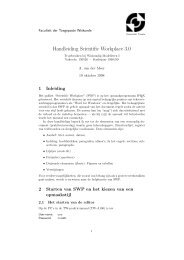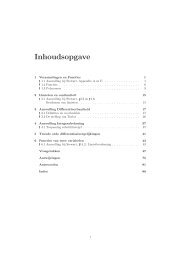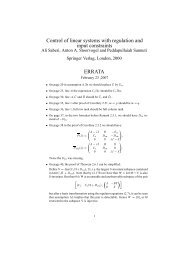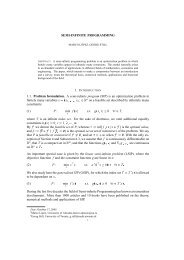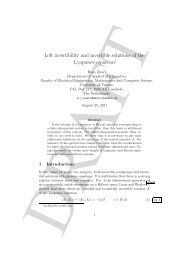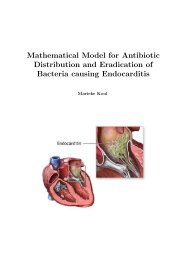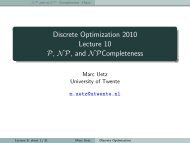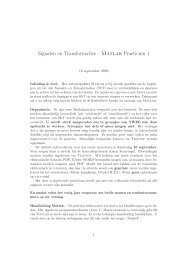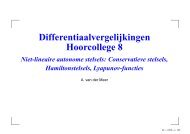Lecture Notes Discrete Optimization - Applied Mathematics
Lecture Notes Discrete Optimization - Applied Mathematics
Lecture Notes Discrete Optimization - Applied Mathematics
You also want an ePaper? Increase the reach of your titles
YUMPU automatically turns print PDFs into web optimized ePapers that Google loves.
Similarly, we can show that<br />
|h|= ∑ h(s,v)= ∑ f(s,v)+ ∑ g(s,v)=| f|+|g|.<br />
v∈V<br />
v∈V<br />
v∈V<br />
An augmenting path is a simple s,t-path P in the residual graph G f . Let P be an augmenting<br />
path in G f . All edges of P are residual edges. Thus, there exists some x>0 such<br />
that we can send x flow units additionally along P without exceeding the capacity of any<br />
edge. In fact, we can choose x to be as large as the residual capacity r f (P) of P which is<br />
defined as<br />
r f (P)=min{r f (u,v) | e∈P}.<br />
Note that if we increase the flow of an edge (u,v) ∈ P by x = r f (P), then we also have<br />
to decrease the flow value on(v,u) by x because of the skew symmetry property. We will<br />
also say that we augment the flow f along path P. See Figure 6 for an example.<br />
Lemma 5.2. Let f be a flow in G and let P be an augmenting path in G f . Then f ′ :<br />
V ×V →Rwith ⎧<br />
⎪⎨ f(u,v)+r f (P) if (u,v)∈P<br />
f ′ (u,v)= f(u,v)−r f (P) if (v,u)∈P<br />
⎪⎩<br />
f(u,v) otherwise<br />
is a flow in G of value| f ′ |=| f|+r f (P).<br />
Proof. Observe that f ′ can be decomposed into the original flow f and a flow f P that<br />
sends r f (P) units of flow along P and−r f (P) flow units along the reversed path of P, i.e.,<br />
the path that we obtain from P if we reverse the direction of every edge e∈P. Clearly, f P<br />
is a flow in G f of value r f (P). By Lemma 5.1, the combined flow f ′ = f + f P is a flow in<br />
G of value| f ′ |=| f|+r f (P).<br />
5.3 Ford-Fulkerson Algorithm<br />
The observations above already suggest a first algorithm for the max-flow problem: Initialize<br />
f to be the zero flow, i.e., f(u,v)=0 for all u,v∈ V. Let G f be the residual graph<br />
with respect to f . If there exists an augmenting path P in the residual graph G f , then<br />
augment f along P and repeat; otherwise terminate. This algorithm is also known as the<br />
Ford-Fulkerson algorithm and is summarized in Algorithm 7.<br />
Note that it is not clear that the algorithm terminates nor that the computed flow is of<br />
maximum value. The correctness of the algorithm will follow from the max-cut min-flow<br />
theorem (Theorem 5.3) discussed in the next section.<br />
The running time of the algorithm depends on the number of iterations that we need<br />
to perform. Every single iteration can be implemented to run in time O(m). If all edge<br />
capacities are integral, then it is easy to see that after each iteration the flow value increases<br />
by at least one. The total number of iterations is therefore at most | f ∗ |, where f ∗ is a<br />
30



